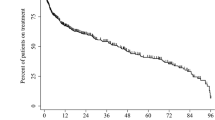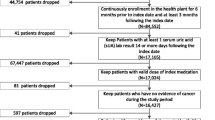Abstract
Objective
The objectives of our study were to compare the efficacy of febuxostat with allopurinol in Thai subjects with gout, as well as to determine the predictive factors of responsiveness to urate-lowering agents and to evaluate the safety of febuxostat in a real-world setting.
Methods
The study was a retrospective cohort study; a total of 354 gout patients were recruited from February 2015 to November 2018. The patients were categorized according to prescription of allopurinol or febuxostat. Demographic data, comorbidities, concomitant medications, gout-related clinical parameters, and the laboratory results were collected. The serial serum urate (sUA) levels were recorded at the beginning of the treatment (baseline), and after treatment at 12 weeks, 18 weeks, and 27 weeks. The primary efficacy endpoint was the achievement of target urate of < 6 mg/dl in people taking febuxostat, compared with those taking allopurinol. The secondary endpoints were the predictive factors of achieving target urate level and adverse drug reactions in patients taking febuxostat. Multivariable regression analysis was used to determine factors associated with achieving target serum urate.
Results
After the treatment, the febuxostat groups had significantly lower mean sUA compared with the allopurinol groups across all follow-up periods. The proportion of people who achieved target serum urate was also higher in the febuxostat groups compared with the allopurinol groups throughout the follow-up periods. The multivariable regression analysis showed that febuxostat 40 mg (OR = 10.96 (95% CI 4.32–27.80); p value < 0.001), febuxostat 80 mg (OR = 9.54 (95% CI 3.91–23.28), smoking (OR = 2.35 (95% CI 1.13–4.91); p value = 0.023), and low baseline serum urate (OR = 0.62 (95% CI 0.52–0.74); p value < 0.001) were associated with the achievement of target serum urate. No adverse drug reaction from febuxostat was observed even among people with renal insufficiency.
Conclusion
In a Thai cohort, people receiving febuxostat are more likely to achieve target serum urate level, compared with people receiving allopurinol. Febuxostat (40 or 80 mg), smoking, and low baseline serum urate were associated with the achievement of target serum urate.
Key points: • Febuxostat showed superior urate-lowering efficacy compared with allopurinol in an Asian population. • In addition to febuxostat, lower baseline serum urate level and history of smoking were associated with achieving target serum urate in gout patients. |

Similar content being viewed by others
References
Singh JA, Cleveland JD (2019) Gout is associated with a higher risk of chronic renal disease in older adults: a retrospective cohort study of U.S. Medicare population. BMC Nephrol 20(1):93. https://doi.org/10.1186/s12882-019-1274-5
Elfishawi MM, Zleik N, Kvrgic Z, Michet CJ Jr, Crowson CS, Matteson EL, Bongartz T (2019) Changes in the presentation of incident gout and the risk of subsequent flares: a population-based study over 20 years. J Rheumatol 47:613–618. https://doi.org/10.3899/jrheum.190346
Towiwat P, Chhana A, Dalbeth N (2019) The anatomical pathology of gout: a systematic literature review. BMC Musculoskelet Disord 20(1):140. https://doi.org/10.1186/s12891-019-2519-y
Foody J, Turpin RS, Tidwell BA, Lawrence D, Schulman KL (2017) Major cardiovascular events in patients with gout and associated cardiovascular disease or heart failure and chronic kidney disease initiating a xanthine oxidase inhibitor. Am Health Drug Benefits 10(8):393–401
Khanna D, Fitzgerald JD, Khanna PP et al (2012) American College of Rheumatology guidelines for management of gout. Part 1: systematic nonpharmacologic and pharmacologic therapeutic approaches to hyperuricemia. Arthritis Care Res (Hoboken) 64(10):1431–1446. https://doi.org/10.1002/acr.21772
Richette P, Doherty M, Pascual E, Barskova V, Becce F, Castañeda-Sanabria J, Coyfish M, Guillo S, Jansen TL, Janssens H, Lioté F, Mallen C, Nuki G, Perez-Ruiz F, Pimentao J, Punzi L, Pywell T, So A, Tausche AK, Uhlig T, Zavada J, Zhang W, Tubach F, Bardin T (2017) 2016 updated EULAR evidence-based recommendations for the management of gout. Ann Rheum Dis 76(1):29–42. https://doi.org/10.1136/annrheumdis-2016-209707
Hui M, Carr A, Cameron S, Davenport G, Doherty M, Forrester H, Jenkins W, Jordan KM, Mallen CD, McDonald TM, Nuki G, Pywell A, Zhang W, Roddy E, for the British Society for Rheumatology Standards, Audit and Guidelines Working Group (2017) The British Society for Rheumatology guideline for the management of gout. Rheumatology (Oxford) 56(7):1246. https://doi.org/10.1093/rheumatology/kex250
Lerch M, Mainetti C, Terziroli Beretta-Piccoli B, Harr T (2018) Current perspectives on Stevens-Johnson syndrome and toxic epidermal necrolysis. Clin Rev Allergy Immunol 54(1):147–176. https://doi.org/10.1007/s12016-017-8654-z
Becker MA, Schumacher HR, Espinoza LR et al (2010) The urate-lowering efficacy and safety of febuxostat in the treatment of the hyperuricemia of gout: the CONFIRMS trial. Arthritis Res Ther 12(2):R63. https://doi.org/10.1186/ar2978
Singh JA, Akhras KS, Shiozawa A (2015) Comparative effectiveness of urate lowering with febuxostat versus allopurinol in gout: analyses from large U.S. managed care cohort. Arthritis Res Ther 17:120. https://doi.org/10.1186/s13075-015-0624-3
Kimura K, Hosoya T, Uchida S, Inaba M, Makino H, Maruyama S, Ito S, Yamamoto T, Tomino Y, Ohno I, Shibagaki Y, Iimuro S, Imai N, Kuwabara M, Hayakawa H, Ohtsu H, Ohashi Y, Kimura K, Hosoya T, Ito S, Inaba M, Tomino Y, Uchida S, Makino H, Matsuo S, Yamanaka H, Yamamoto T, Ohno I, Shibagaki Y, Iimuro S, Imai N, Kuwabara M, Hayakawa H, Akizawa T, Teramoto T, Kasanuki H, Yoshimura K, Kimura K, Hosoya T, Shibagaki Y, Ohno I, Sato H, Uchida S, Horikoshi S, Maruyama S, Inaba M, Moriwaki Y, Uchida H, Kaneshiro N, Imai N, Moriya H, Komatsu Y, Kaname S, Hanaoka K, Ogura M, Ikeda M, Kasai K, Sugiura A, Takahashi K, Kojima K, Nitta K, Tamai H, Nagaya H, Okuno S, Kakiya R, Takeoka H, Hirata K, Asano K, Fukaya Y, Iwaida Y, Tsuneda Y, Nishimura S, Hiramatsu T, Isaka Y, Ito T, Yuzawa Y, Yamagata K, Sofue T, Jinguji Y, Hirano K, Matsuyama K, Mizumoto T, Shibuya Y, Sugawara M, Kadomura M, Teshima Y, Ohtani H, Kamata H, Okawara S, Fukushima M, Takemura K, Kinugasa E, Kogure M, Ehara Y (2018) Febuxostat therapy for patients with stage 3 CKD and asymptomatic hyperuricemia: a randomized trial. Am J Kidney Dis 72(6):798–810. https://doi.org/10.1053/j.ajkd.2018.06.028
Tanaka A, Taguchi I, Teragawa H, Ishizaka N, Kanzaki Y, Tomiyama H, Sata M, Sezai A, Eguchi K, Kato T, Toyoda S, Ishibashi R, Kario K, Ishizu T, Ueda S, Maemura K, Higashi Y, Yamada H, Ohishi M, Yokote K, Murohara T, Oyama JI, Node K, on behalf of the PRIZE study investigators (2020) Febuxostat does not delay progression of carotid atherosclerosis in patients with asymptomatic hyperuricemia: a randomized, controlled trial. PLoS Med 17(4):e1003095. https://doi.org/10.1371/journal.pmed.1003095
Kojima S, Matsui K, Hiramitsu S, Hisatome I, Waki M, Uchiyama K, Yokota N, Tokutake E, Wakasa Y, Jinnouchi H, Kakuda H, Hayashi T, Kawai N, Mori H, Sugawara M, Ohya Y, Kimura K, Saito Y, Ogawa H (2019) Febuxostat for cerebral and cardiorenovascular events prevention study. Eur Heart J 40(22):1778–1786. https://doi.org/10.1093/eurheartj/ehz119
Neogi T, Jansen TL, Dalbeth N et al (2015) 2015 gout classification criteria: an American College of Rheumatology/European League Against Rheumatism collaborative initiative. Ann Rheum Dis 74(10):1789–1798. https://doi.org/10.1136/annrheumdis-2015-208237
Becker MA, Schumacher HR, MacDonald PA et al (2009) Clinical efficacy and safety of successful longterm urate lowering with febuxostat or allopurinol in subjects with gout. J Rheumatol 36(6):1273–1282. https://doi.org/10.3899/jrheum.080814
Edwards NL (2008) Febuxostat : a viewpoint by N. Lawrence Edwards. Drugs 68(13):1875–1876. https://doi.org/10.2165/00003495-200868130-00007
Jackson RL, Hunt B, MacDonald PA (2012) The efficacy and safety of febuxostat for urate lowering in gout patients ≥65 years of age. BMC Geriatr 12:11. https://doi.org/10.1186/1471-2318-12-11
Huang X, Du H, Gu J et al (2014) An allopurinol-controlled, multicenter, randomized, double-blind, parallel between-group, comparative study of febuxostat in Chinese patients with gout and hyperuricemia. Int J Rheum Dis 17(6):679–686. https://doi.org/10.1111/1756-185X.12266
Nuki G, Doherty M, Richette P (2017) Current management of gout: practical messages from 2016 EULAR guidelines. Pol Arch Intern Med 127(4):267–277. https://doi.org/10.20452/pamw.4001
Waller A, Jordan KM (2017) Use of febuxostat in the management of gout in the United Kingdom. Ther Adv Musculoskelet Dis 9(2):55–64. https://doi.org/10.1177/1759720X16682010
Schumacher HR Jr, Becker MA, Wortmann RL et al (2008) Effects of febuxostat versus allopurinol and placebo in reducing serum urate in subjects with hyperuricemia and gout: a 28-week, phase III, randomized, double-blind, parallel-group trial. Arthritis Rheum 59(11):1540–1548. https://doi.org/10.1002/art.24209
Koide H, Hira D, Tsujimoto M, Katsube Y, Minegaki T, Uzu T, Ikeda Y, Morita SY, Nishiguchi K, Terada T (2017) Previous dosage of allopurinol is a strong determinant of febuxostat efficacy. Biol Pharm Bull 40(5):681–686. https://doi.org/10.1248/bpb.b16-00972
Mu Z, Wang W, Wang J, Lv W, Chen Y, Wang F, Yu X, Wang Y, Cheng B, Wang Z (2019) Predictors of poor response to urate-lowering therapy in patients with gout and hyperuricemia: a post-hoc analysis of a multicenter randomized trial. Clin Rheumatol 38:3511–3519. https://doi.org/10.1007/s10067-019-04737-5
Katayama A, Yokokawa H, Fukuda H, Ono Y, Isonuma H, Hisaoka T, Naito T (2019) Achievement of target serum uric acid levels and factors associated with therapeutic failure among Japanese men treated for hyperuricemia/gout. Intern Med 58(9):1225–1231. https://doi.org/10.2169/internalmedicine.1899-18
Hatoum H, Khanna D, Lin SJ et al (2014) Achieving serum urate goal: a comparative effectiveness study between allopurinol and febuxostat. Postgrad Med 126(2):65–75. https://doi.org/10.3810/pgm.2014.03.2741
Sheer R, Null KD, Szymanski KA, Sudharshan L, Banovic J, Pasquale M (2017) Predictors of reaching a serum uric acid goal in patients with gout and treated with febuxostat. Clinicoecon Outcomes Res 9:629–639. https://doi.org/10.2147/CEOR.S139939
Kojima S, Matsui K, Ogawa H, Jinnouchi H, Hiramitsu S, Hayashi T, Yokota N, Kawai N, Tokutake E, Uchiyama K, Sugawara M, Kakuda H, Wakasa Y, Mori H, Hisatome I, Waki M, Ohya Y, Kimura K, Saito Y, Febuxostat for Cerebral and Cardiorenovascular Events Prevention Study (FREED) investigators (2017) Rationale, design, and baseline characteristics of a study to evaluate the effect of febuxostat in preventing cerebral, cardiovascular, and renal events in patients with hyperuricemia. J Cardiol 69(1):169–175. https://doi.org/10.1016/j.jjcc.2016.02.015
Saag KG, Whelton A, Becker MA, MacDonald P, Hunt B, Gunawardhana L (2016) Impact of febuxostat on renal function in gout patients with moderate-to-severe renal impairment. Arthritis Rheumatol 68(8):2035–2043. https://doi.org/10.1002/art.39654
Sircar D, Chatterjee S, Waikhom R, Golay V, Raychaudhury A, Chatterjee S, Pandey R (2015) Efficacy of febuxostat for slowing the GFR decline in patients with CKD and asymptomatic hyperuricemia: a 6-month, double-blind, randomized, Placebo-Controlled Trial. Am J Kidney Dis 66(6):945–950. https://doi.org/10.1053/j.ajkd.2015.05.017
Tsuruta Y, Kikuchi K, Tsuruta Y, Sasaki Y, Moriyama T, Itabashi M, Takei T, Uchida K, Akiba T, Tsuchiya K, Nitta K (2015) Febuxostat improves endothelial function in hemodialysis patients with hyperuricemia: a randomized controlled study. Hemodial Int 19(4):514–520. https://doi.org/10.1111/hdi.12313
Mitsuboshi S, Yamada H, Nagai K, Okajima H (2015) Switching from allopurinol to febuxostat: efficacy and tolerability in hemodialysis patients. J Pharm Health Care Sci 1:28. https://doi.org/10.1186/s40780-015-0028-1
Author information
Authors and Affiliations
Corresponding author
Ethics declarations
Disclosures None.
Additional information
Publisher’s note
Springer Nature remains neutral with regard to jurisdictional claims in published maps and institutional affiliations.
Electronic supplementary material
ESM 1
(PDF 530 kb)
Rights and permissions
About this article
Cite this article
Lertnawapan, R., Jatuworapruk, K. Efficacy of febuxostat versus allopurinol and the predictors of achieving target serum urate in a cohort of Thai people with gout. Clin Rheumatol 40, 255–262 (2021). https://doi.org/10.1007/s10067-020-05262-6
Received:
Revised:
Accepted:
Published:
Issue Date:
DOI: https://doi.org/10.1007/s10067-020-05262-6




